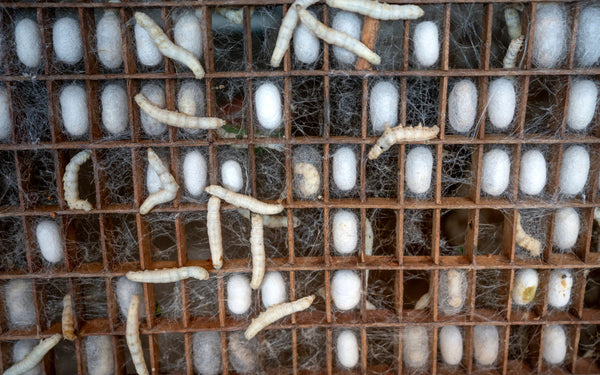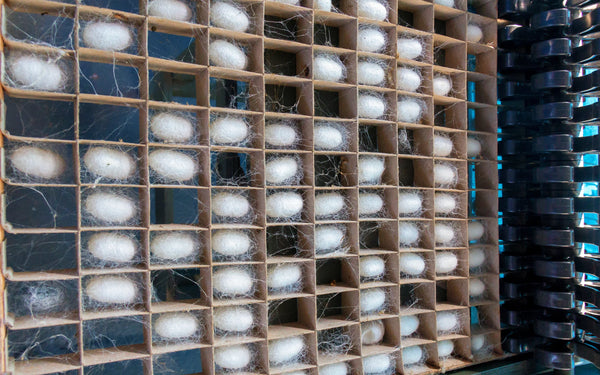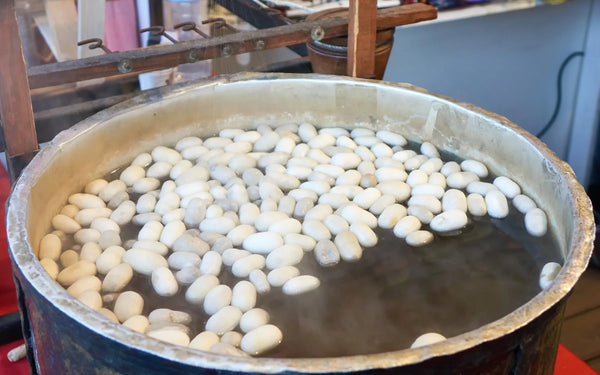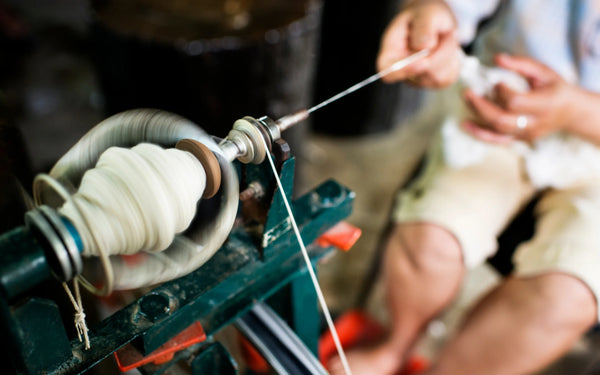Key Takeaways
silk is produced by the silkworm, or mulberry bombyx, which feeds exclusively on mulberry leaves . After several molts, the worm weaves a cocoon in which it transforms into a chrysalis before emerging like a butterfly . breeding of silkworm, or sericulture, is an age-old tradition, practiced in magnaneries. The extraction of the precious silk thread from the cocoon requires a skillful spinning process. Although fascinating, silk production today represents an environmental and economic challenge.
The French brand The Oversized Hoodie® 🇫🇷 is famous for its textile expertise, notably its collection of high-end, Oeko certified 100% natural mulberry silk products -Tex® Standard 100. Free from toxic and chemical substances, and ecological, the collections silk pillowcase, night mask silk and silk sheets stand out for their incomparable softness and excellent value for money, providing an unrivaled feeling of comfort.
The Mulberry Bombyx and its role in silk production
The silkworm which produces silk is known by the scientific name Bombyx mori. It is a butterfly domesticated for millennia, incapable of surviving in the wild state without help from man.
The mulberry bombyx plays a crucial role in silk production. Indeed, this silkworm is the only insect capable of producing a silk thread strong enough to be used in textile manufacturing.
Thanks to the sericogenic glands located in its head, the bombyx secretes sericin, a liquid protein which hardens on contact with air to form the precious silk thread.
At The Oversized Hoodie®, we are fascinated by the unique and meticulous process that allows silkworms to produce their precious thread. It is thanks to this exceptional material that we make our 100% natural mulberry silk products such as pillowcases, sleep masks, night caps and all night linen.
— Geoffrey, Founder of The Oversized Hoodie®

Also read: How is silk made ?
The life cycle of the silkworm: from caterpillar to butterfly
The life cycle of the bombyx, from egg to adult butterfly, includes several fascinating stages. Let's examine them in detail:
The birth and growth of silkworms
It all starts with the mating of the male butterfly and female, which takes place in summer. Following this, the female lays between 300 and 500 eggs, which she securely attaches to mulberry branches.
After an incubation of about 10 days, tiny silkworms hatch. They are 3mm long at birth, but grow quickly, molding their skin as they get bigger.
Within 1 month, the caterpillar reaches 8 to 10 cm in length. She is then ready to spin her protective cocoon.
The transformation of the worm into a caterpillar
During its growth, the silkworm goes through 5 larval stages, separated by molts.
During each molt, the silkworm stops feeding and weaves a thread to hang itself. It then sheds its old skin, which shrivels. The new skin feels tight at first, but hardens quickly.
After each molt, the silkworm grows larger and becomes more active.
The evolution of the cocooned caterpillar
Once it reaches maturity, the caterpillar stops and begins to weave its protective cocoon around itself. It secretes a continuous thread approximately 1 km long!
The cocoon is made of silk fibers interwoven so tightly that water cannot pass through. Inside, the caterpillar transforms into a chrysalis.
The metamorphosis of the cocoon into a butterfly
After 2 to 3 weeks in the cocoon, the chrysalis metamorphoses into a butterfly thanks to the digestive enzymes that it secretes.
It also secretes an alkaline liquid which partially dissolves the cocoon, allowing it to escape. The bombyx butterfly then emerges with its magnificent wings and an atrophied proboscis, preventing it from feeding.
It only lives a few days, time to mate and lay eggs to ensure a new generation of silkworms.

Also read: Which animal produces silk ?
Rearing silkworms: an ancestral practice
Silkworm breeding, called sericulture, dates back to ancient times. Legend attributes its discovery to a Chinese princess around the year 2640 BC. AD Subsequently, sericulture spread in Asia, particularly in Japan and India. It reached Europe in the Middle Ages, first in the Mediterranean basin, then in France with a boom in Touraine in the 15th century.
Today, China remains the world's leading producer of silk, with nearly 150,000 tonnes per year. The breeding process begins with incubation of eggs in a room maintained at 25°C. The young worms are then fed chopped mulberry leaves.
As they grow, they are given larger leaves. The breeder must carefully monitor the temperature, ventilation, and hygiene of the silkworm farm.

Also read: Which country invented silk ?
The role of mulberry trees in feeding silkworms
The silkworm, or bombyx, feeds exclusively on mulberry leaves throughout its life. Two species of mulberry are mainly used: the white mulberry, or Morus alba, giving white silk, and the black mulberry, or Morus nigra, giving yellow silk.
Mulberry trees are grown in plantations located near the silkworm factories. The ideal is to have several varieties to spread out the harvests. The leaves are collected manually before being chopped to feed the worms.
Each silkworm consumes approximately 1 kg of leaves to produce 10 to 15 grams of cocoon!
As specialists in cocooning and relaxation clothing, we know how difficult it is to obtain a textile that is both resistant, supple and soft. Silk has these qualities thanks to the remarkable biological process carried out by the silkworm.
— Geoffrey, Founder of The Oversized Hoodie®

Also read: Where the silkworm lives ?
La Magnanerie: the place where silkworms are bred
The silkworm farm designates the building where the silkworms are raised. Its layout and maintenance are crucial to obtain quality silk.
The development and maintenance of a Magnanerie
The silkworm farm is divided into rooms dedicated to each stage of the life cycle of the silkworm. We find there:
- The incubator, heated room for hatching the eggs.
- The nursery where the young worms grow.
- The "education rooms" for the oldest.
- The feeding room to store the sheets.
- The cocoon room to collect the cocoons.
The breeder must ensure that the ideal temperature is maintained between 20 and 25°C. Ventilation is also essential to avoid illness. Hygiene must be impeccable, with regular cleaning of shelves and equipment.
The role of the breeder in the management of the Magnanerie
The silkworm breeder must carry out constant monitoring of the herd throughout the breeding cycle. His main tasks are:
- Place the eggs in the incubator then transfer the young worms to the nursery.
- Feed the worms with mulberry leaves several times a day.
- Clean and disinfect facilities.
- Sort worms by size and transfer them to new chambers.
- Identify and eliminate diseased worms.
- Collect the cocoons once woven.
- Check the temperature and humidity.
The breeder must be very meticulous, observant and responsive. The success of breeding depends on its skills in managing the life cycle of the silkworm.

Also read: Where is silk produced in France ?
Silk production: a complex process
Making silk requires several delicate steps once the worm has woven its cocoon.
The weaving of the cocoon by the silkworm
When it reaches its final size of 8 to 10 cm, the silkworm weaves its cocoon in uninterrupted circular movements. It secretes sericin through its glands and causes it to solidify by exposing it to air. The wire measures between 300 and 900 m long! The finished cocoon is oval and approximately 3 cm long. It is composed of a single continuous thread.
Extracting silk thread from the cocoon
After harvesting, obtaining the silk thread is done in several stages:
- The cocoons are sorted, washed and classified by quality.
- They are immersed in hot water to soften the natural glue.
- The wires are then carefully unwound to obtain continuous strands.
- Several strands are gathered and twisted to form a thread.
- The yarn is conditioned and woven to obtain textile.
This very delicate spinning requires specific know-how to avoid damaging the precious silk threads.

The contemporary challenges and issues of sericulture
Although ancestral, silk production faces growing ecological and economic challenges:
- Intensive sericulture wears out the soil, particularly because of mulberry monocultures.
- Silkworm breeding consumes a lot of water.
- Labor is expensive in developed countries.
- Competition from synthetic fibers is tough.
- Consumers are increasingly favoring natural and ecological materials.
However, solutions exist for more sustainable production:
- Choose mulberry varieties that use less water.
- Modernize breeding techniques to reduce energy consumption.
- Highlight the hygienic and aesthetic qualities of silk.
- Target a high-end market by focusing on luxury and artisanship.
Thanks to these efforts, sericulture remains sustainable, particularly in China, India, and more confidentially in Europe.
Conclusion
The production of silk by the silkworm is an absolutely fascinating, but extremely complex, process. From the life of the bombyx to the making of silk fabrics, each step requires time, expertise and attention to detail.
Although sericulture faces contemporary challenges, the precious nature of silk should ensure it a lasting place in the world of textiles and of fashion.
| Appearance | Description | Significance | Process |
|---|---|---|---|
| Silkworm | Mulberry Bombyx | Silk producer | Transformation into cocoon |
| Power supply | Mulberry leaves | Essential for growth | Exclusive food |
| Cocoon | Silk thread of approximately 1 km | Silk Source | Worm weaving |
| Sericulture | Silkworm breeding | A thousand-year-old tradition | Management and harvest |
| Spinning | Extraction of silk thread | Key production stage | Delicate process |
| Issues | Ecological and economic challenges | Impact on industry | Sustainable practices |
FAQ
How are silkworms born ?
Silkworms are born from eggs laid by the female mulberry bombyx butterfly. After mating, it lays between 300 to 500 eggs which it attaches to mulberry branches. After around ten days of incubation, the tiny silkworms hatch.
How the silkworm lives ?
The silkworm lives in breeding in silkworm farms. It feeds exclusively on mulberry leaves. Throughout its growth, it molts several times. After about a month, it weaves its silk cocoon in which it becomes a chrysalis, before transforming into a butterfly.
Does the silkworm turn into a butterfly ?
Yes, the silkworm begins a metamorphosis inside its cocoon to become a mulberry bombyx butterfly. This transformation takes place after approximately 3 weeks spent in the chrysalis state in the cocoon.
Where the silkworm lives ?
The silkworm lives in dedicated facilities called silkworms. These buildings bring together all the rooms adapted to the different stages of their development: incubator, nursery, breeding room, leaf reserve, etc.
What is the name of a silkworm breeder ?
The silkworm breeder bears the name of sericulturist. He is an expert who watches over the entire life cycle of the worms, from the incubation of the eggs to the harvesting of the cocoons.
Updated February 1, 2024







